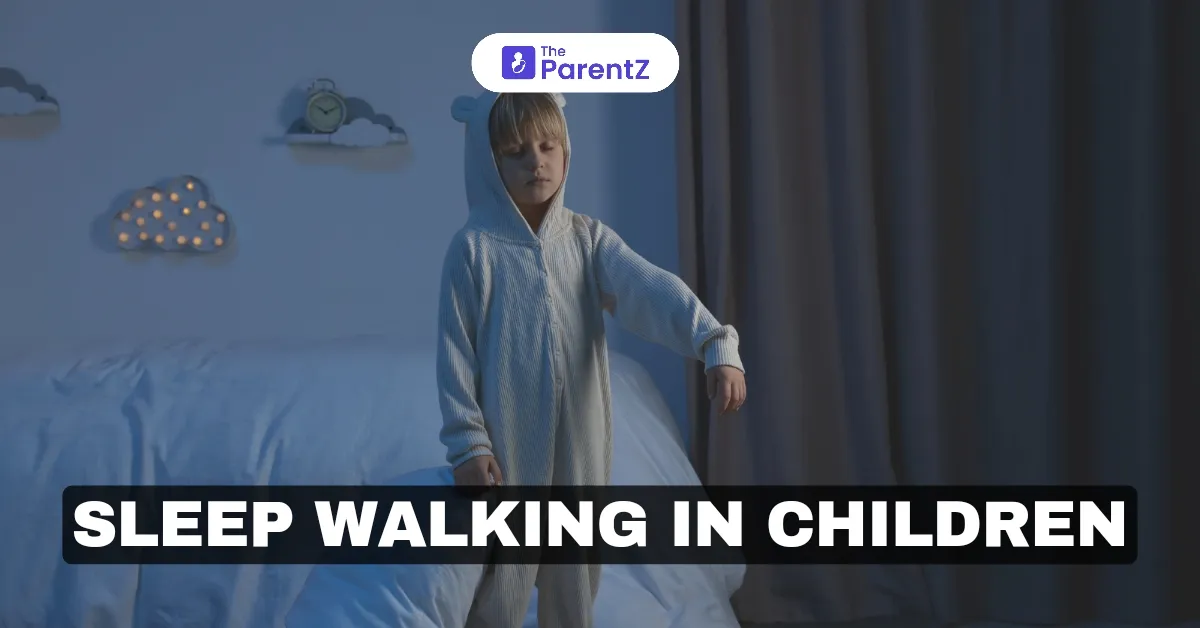Sleepwalking, also known as somnambulism, is a sleep disorder in which a child appears to wake up and move around while still asleep. It can range from simple movements, such as sitting up in bed, to more complex behaviors like walking or even performing routine tasks. While typically harmless, sleepwalking can sometimes pose risks if the child moves into dangerous situations. This article explores the causes, symptoms, risks, and management of sleepwalking in children.
How Common is Sleepwalking in Children?
Sleepwalking is relatively common in children, affecting around 15% of them at least once. It often begins between the ages of 4 and 8, and most children outgrow it by their teen years.
Causes of Sleepwalking in Children
Several factors may contribute to sleepwalking episodes in children:
1. Genetics
• Sleepwalking often runs in families. If one or both parents have a history of sleepwalking or other parasomnias, children are more likely to experience it as well.
2. Sleep Deprivation
• Inadequate sleep can trigger sleepwalking episodes. Fatigue disrupts normal sleep cycles, increasing the likelihood of sleepwalking.
3. Stress and Anxiety
• Emotional stress or changes in routine (such as a new school or family event) can lead to sleep disturbances, including sleepwalking.
4. Sleep Disorders
• Sleep disorders like sleep apnea or restless leg syndrome may co-occur with sleepwalking and can contribute to frequent episodes.
5. Fever or Illness
• Children who are sick or have a fever may experience temporary sleepwalking episodes due to sleep disruption caused by the illness.
6. Medications
• Certain medications that affect the central nervous system can increase the likelihood of sleepwalking in children.
Symptoms of Sleepwalking in Children
Sleepwalking behaviors can vary and may include:
• Sitting up in bed: The child may sit up and look around as though awake, though still asleep.
• Walking or moving around: Children may get out of bed and walk around, sometimes moving to another room.
• Performing routine tasks: Some children may engage in familiar tasks like opening doors or playing with toys.
• Blank or glazed expression: A sleepwalking child’s eyes may be open, but they have a blank or unfocused look.
• Inability to respond or remember: Sleepwalking children usually do not respond to others and have no recollection of the episode.
Risks Associated with Sleepwalking in Children
Sleepwalking can sometimes be risky, as children may unknowingly place themselves in unsafe situations. Possible risks include:
• Injury from falling: Children may trip, stumble, or fall while sleepwalking.
• Leaving the house: In rare cases, children may attempt to leave the house, which could be dangerous if left unsupervised.
• Interaction with objects: A child may accidentally harm themselves by interacting with sharp or hazardous objects.
How to Manage Sleepwalking in Children
1. Establish a Regular Sleep Routine
• Consistent sleep routines can help improve sleep quality and reduce sleepwalking episodes. Ensure that your child has a regular bedtime and gets sufficient sleep for their age.
2. Create a Safe Sleep Environment
• Make sure your child’s bedroom and surrounding areas are free of hazards. Lock windows, secure stairways, and consider using child-proof locks on doors if necessary.
3. Reduce Stress Before Bedtime
• Help your child relax before bed by encouraging calming activities, such as reading, taking a warm bath, or listening to soothing music. Reducing screen time an hour before bed can also help.
4. Avoid Waking During an Episode
• Attempting to wake a sleepwalking child may lead to confusion or agitation. Instead, gently guide them back to bed if needed, ensuring they remain safe.
5. Track and Identify Triggers
• Keep a sleep diary to note any patterns or triggers for your child’s sleepwalking, such as stressors or inconsistent sleep. This can help in managing or preventing future episodes.
When to Consult a Healthcare Professional
While sleepwalking is usually harmless, consider seeking medical advice if:
• Episodes are frequent and intense, disrupting the child’s or family’s sleep.
• The child shows signs of other sleep disorders, such as loud snoring (possible sign of sleep apnea).
• Sleepwalking episodes place the child in risky situations.
• The behavior persists into adolescence or seems to worsen over time.
Final Thoughts on Sleepwalking in Children
Sleepwalking in children is a common, generally harmless condition that often resolves on its own as the child grows. Parents can help manage episodes by promoting good sleep habits, minimizing stress, and creating a safe environment. With patience and proper precautions, sleepwalking can be effectively managed, allowing for safe and restful sleep for both children and their families.








Be the first one to comment on this story.